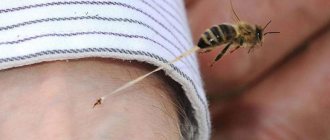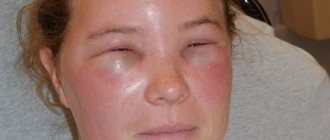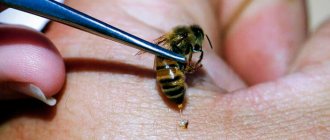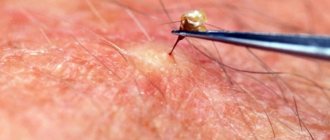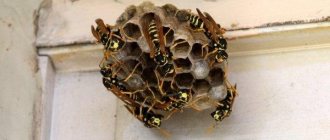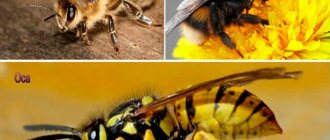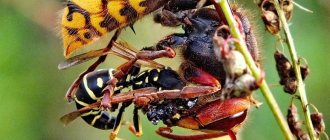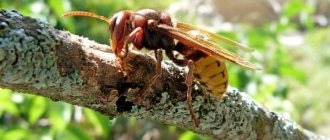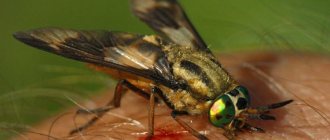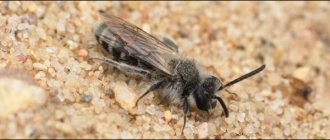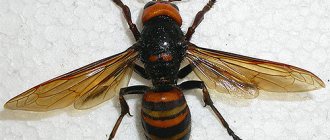A bee is a quite useful insect that produces wax, honey, and propolis. However, despite its benefits, many people are afraid of it. The reason for this is a bee sting.
Bees are not the only insects that bite humans. There are many others that harm humans, such as wasps, bumblebees, house ants, cockroaches and bedbugs. But today we will talk about bees.
To prevent undesirable consequences after a bee sting, you need to have an idea of how dangerous it is, what the body’s reactions may be and how to act in such a situation.
General information
Bee stings occur frequently, especially in the warm season.
They are quite painful, and after a bite, redness and swelling appear at the site of the lesion. As a rule, such symptoms soon disappear and the person feels normal. But in some cases, insect bites, particularly bees, can lead to allergic reactions that can be life-threatening. Therefore, it is very important to provide the victim with timely first aid and monitor his condition. And those who are prone to allergic reactions should be given immediate hospitalization. Indeed, sometimes an allergy can develop even after a person is stung by one insect. But multiple bites are especially dangerous. Bee venom, which the insect introduces into the body through its sting, is dangerous for humans. And when attacked by a large number of bees, a general toxic reaction can develop, which is expressed by a significant deterioration in the general condition. Sometimes this condition is deadly. What symptoms can develop from bee stings, and what needs to be done to quickly alleviate the victim’s condition, can be found in this article.
Content
- Why and how bees sting
- Why are bee stings painful?
- How to prevent bites
- First aid for bites and principles of treatment
Bees play a key role in pollinating flowering plants, including the fruits and vegetables we eat and the flowers that grow in our gardens. Despite the useful functions that striped insects perform, many of us fear them like fire. To overcome this fear, it is important to understand the behavior of bees - in what situations they use their sting, and how to prevent bee stings.
Pathogenesis
Bees have sharp stings that are located on the abdomen - at its rear end. The insect injects poison through its sting, which causes pain, irritation, and sometimes allergic reactions. Unlike other insects, bees leave a sting in the wound. The sting can gradually go deeper on its own and at the same time release poison. That is why it needs to be removed as soon as possible.
Bee venom contains phospholipase A , which produces a hemolyzing effect. red blood cells disintegrate at the site of exposure . Melittin is a linear polypeptide that has toxic effects. Under its influence, edema forms, blood vessels become more permeable, convulsions and coronary disorders develop. Apamin is a powerful neurotoxin that affects the bulbar centers as well as the spinal cord. It may depress breathing. However, if a person is bitten by one insect, then the concentration of the substance is not sufficient to cause pronounced pathological reactions. But with multiple bites, the reaction can be pronounced.
If an allergic reaction develops, it can occur in the form of anaphylactic shock , angioedema, or urticaria .
Why does a bee die after being stung?
The bee has a sting located at the end of its abdomen. It is used as a defense and releases poison when bitten. The sting can be used repeatedly to protect against other insects. But a bee can only bite an animal or a person once - then it dies.
Why does a bee die after a human attack? If a bee attacks a person or animal, then it is not able to pull the sting back, so the barbs on it get caught in the soft skin. To free itself, the bee makes sharp jerks. Having pulled out the sting, part of the intestine remains, causing the insect to die.
Why can't you kill a bee if it stings or attacks you?
If you kill a bee, its body releases a certain substance that acts as a military alarm: other bees will flock to you.
Classification
Depending on the severity of the process, the condition is divided into several types:
- Mild - only local signs appear, there are no pronounced general symptoms. It is noted after the bite of one or more insects.
- Moderate – characterized by local symptoms, as well as moderate manifestation of general symptoms. Develops as a consequence of the toxic effects of poison. Urticaria may develop , as well as angioedema , which does not affect the airways. Hypersensitivity reactions are possible. The functions of the nervous system are disrupted if a person is bitten by several dozen insects.
- Severe – anaphylactic shock and severe toxic reactions . An allergy to a bee sting can lead to obstruction of the upper respiratory tract. The central nervous system and peripheral nervous system are affected. An allergic reaction most often occurs after a person has been stung by a large number of bees.
Common questions about bee stings
Do young bees that have just left the nest have poison?
Young animals that emerged from the cells less than a day ago cannot sting. The poison is produced on the second or third day of life, and in sufficient quantities only after 10 – 18 days.
How long can swelling last after a bite?
With timely assistance and proper treatment, pain and swelling subsides within 1 to 2 days. But if you have an allergy, the swelling can last up to 7 days.
Does frequent bee stings affect the beekeeper's health?
Apitoxin, in addition to being harmful, has a positive effect on human health. In the absence of allergies, it is able to regulate the function of the pituitary gland, stimulate the formation of corticotropin, which stimulates the work of the adrenal glands. Therefore, frequent bites help increase the body’s defenses, strengthen memory, and reduce psychological stress.
Is it possible to develop immunity to apitoxin?
The body's reaction to a bee sting is variable. With regular exposure to poison, susceptibility to it gradually decreases. But it is worth remembering that if you are allergic to one or more components, the negative reaction, on the contrary, will intensify.
How does the level of intoxication depend on the number of bites?
If a significant amount of apitoxin enters the body, it can lead to serious negative consequences. After 100 or 200 bites, blood pressure drops sharply, nausea, vomiting, dizziness, and fainting appear. Bites are especially dangerous for children and women. Men are less susceptible to poison. Simultaneous stings from 250 bees can lead to rapid death.
Single bee stings do not cause serious harm to the body; you just need to remove the sting and properly treat the wound. If you have a tendency to allergies, it is imperative to use antihistamines and receive medical help.
Symptoms
The most common symptoms that develop after an insect bite are:
- The appearance of a sharp and burning pain, soon the pain may be replaced by itching.
- Redness of the affected area, while a white dot appears in the center where the sting has penetrated.
- Development of edema.
As a rule, with a single bite, the pain and burning sensation does not last long. Then swelling develops. Redness and swelling disappear after a few days; discomfort may subside a little earlier. The papule persists for about a week. If a bee stings the eye area, the swelling may last longer. blepharitis may also develop . If the poison penetrates the mucous membranes, their pronounced swelling is noted.
If an allergic reaction develops, the following manifestations are added to the main symptoms:
- Very severe swelling in the affected area, which progresses quickly.
- Severe itching and rash all over the body.
- Vomiting, nausea.
- Difficulty breathing - a symptom reminiscent of asthma.
In severe cases, vascular collapse may develop, consciousness is depressed, the functioning of the respiratory center is disrupted, and respiratory activity is weakened.
With urticaria , pink blisters appear on the body, which resemble pimples after being attacked by nettles.
With Quincke's edema, those areas of the body where there is a lot of subcutaneous tissue increase. Damage to the upper respiratory tract area is especially dangerous.
In anaphylactic shock , there is generalized itching of the skin, a sharp drop in blood pressure, chest pain, collapse, and loss of consciousness.
Terror that flies on the wings of the night
The carpenter bee, also known as Xylocopa, Greater Tree Bee, Carpenter Bee, Black Bee or Tree Nest Bee (Xylocopa) is a genus of solitary bees in the family Apidae, widely distributed on several continents. They differ from ordinary honey bees in the dark color of the body and wings, larger (20-30 mm) body size and very low aggressiveness.
Xylocopa violacea. In the UK it is called Violet carpenter bee, literally corresponds to the Russian name
Science knows about half a thousand species of carpenter bees, most of which are grouped into 30-35 subgenera, some of which are monophylithic (i.e., include only one species). In Russia and the CIS countries, from April to September, mainly the common carpenter bee (Xylocopa valga) and the purple carpenter bee (Xylocopa violacea) are found.
In Germany it is called Große Blaue Holzbiene, or Blauschwarze, and also Violettflügelige Holzbiene. Large blue wood bee, also blue black or purple bee respectively. Photo: Thomas Steg
Carpenter bees are cosmopolitan. Their range also covers the territory from Western Europe to Central Asia. Common in Ukraine and southern Russia. In recent decades, the appearance of carpenter bees north of the Rostov region has become increasingly frequent. Individual bees were spotted in the Urals and in the Northwestern District.
Favorite delicacies include acacia nectar, linden, clover, fruit crops, and sunflower. However, she is not averse to eating other flowers.
Its large size, dense build and large darkly colored wings allow it to cover long distances even in bad weather. The dark pigment in the wing tissues gives them additional strength, and the glossy shine in some species reflects the heat rays of the Sun, saving the bee from overheating.
Xylocops are solitary bees. This means that they do not build hives, and do not form a strict hierarchy with the queen. Each bee is an independent unit: it provides itself with food and shelter, and independently cares for its offspring. Several weeks - after which it leaves the larvae to their fate. The male is only needed for fertilization - his life span barely exceeds two weeks.
The carpenter bee got its name from the specific way it constructs its nest. The adult female first of all looks for a suitable piece of soft wood, and for some species it is not particularly important whether it is a living tree or part of a building. Sometimes you can find bee “holes” in your fence or window frame.
At the same time, the bee literally gnaws its way with its powerful jaws, which is accompanied by a characteristic sound reminiscent of the work of a saw.
When there was a xylocope in the frame of my window, at first I even thought that mice had gotten into us))
In the absence of a tree, a carpenter bee can also use dead parts of a plant with a tubular stem, for example, hogweed, hogweed or burdock. One of the ancient subgenera Proxylocopa actually digs burrows right in the damp ground.
Each move the bee divides by partitions into 8-12 cells. The number of these cells and the branching of the course depends on the type of bee.
In each cell, the xylocop places a lump of collected pollen, moistened with nectar and glued together with the saliva of the bee itself. It lays one egg in a sweet pie. One lump is food for the larva for the entire growth period, so the bee collects sooooo much pollen and nectar. To collect pollen, it has special pollen folds and passages in the shell. And to collect nectar, she sometimes gnaws through flowers with a long corolla, literally sucking out every last drop.
Why bother trying to get a drop of nectar if you can take a bite and drink it all down?)) Photo: Alvesgaspar
After this, each cell is walled up with an adhesive mass of bee saliva and sawdust, leaving only air access. The mother bee guards her nest for two to three weeks, after which she goes on a journey. The larvae grow all summer, pupate in August-September, and become adults in the fall. They come out only in early spring, gnawing through partitions. An adult bee overwinters, seeking shelter in the form of empty nests, sawfly passages, abandoned hives and crevices in trees and wooden buildings.
Usually one bee from the new generation remains in the nest. So several generations of bees can live in one nest.
Black carpenter bee having lunch. Photo: Bautsch
Are carpenter bees dangerous?
By themselves, no. An adult tree bee is not aggressive; it does not attack people or animals unless you try to catch it or damage the nest. Moreover, until recently, carpenter bees were listed in the Red Book of Russia and Ukraine as a species whose existence is under threat. The reduction in their numbers was facilitated by the active cutting down of broad-leaved forests, as well as the massive treatment of fields with insecticides during the late USSR. Now their numbers are recovering, and their range is expanding to the north and east.
"Who are you? I didn’t call you!”
The sting of a carpenter bee (or rather, a sting - bees do not tend to bite at all))) is stronger and more painful than that of a honey bee, and causes about the same harm - the glands at the base of the sting contain poison, causing painful swelling. For a healthy person this will only cause discomfort, while for people with allergies it can cause a severe reaction, itching, ulceration and Quincke's edema.
However, it is not because of the stings that some summer residents disliked tree bees. When colonizing wooden buildings and supports, bees gnaw long passages. And if in fresh wood one nest does not create any problems (more on this below), then in old wood it can be the last straw. Adding to this the attachment of bees to one place for many generations, as well as all kinds of wood bugs, you can get a beam dotted with passages.
“Don’t bully me here. My great-grandmother built a nest here!”
In addition, the bee can bring with it fungal spores, which will sprout mold literally from inside the tree. Empty nests become shelters for other bees, wasps, as well as nests of grinders and other insects.
To get rid of them, summer residents build special traps and also use special insecticides.
Trap. So, before the species had time to recover, they were exterminated again.
So, the carpenter bee is a very interesting representative of the family. Peaceful carpenter bees usually do not cause problems if left undisturbed. But they delight the eye with their brilliant color.
This is not photoshop. This is Xylocopa caerulea, a blue carpenter bee native to southern Russia. And there is also a diamond and emerald carpenter bee, however, already in Australia)
All the best and don’t get sick!
PS The article was written by biotechnologist Lyudmila Khigerovich and published in the scientific community by Phaneroza. The article relates to the topics of biology hubs, popular science, reading room and is thematic , although this will not stop dislikers...
Sources
Panfilov D. V., Berezin M. V. CARPENTER BEE - Xylocopa valga Gerstaecker, 1872
Barbara Thomas und Rolf Witt (2005): Erstnachweis der Holzbiene Xylocopa violacea (Linné 1758) in Niedersachsen und weitere Vorkommen am nordwestlichen Arealrand (Hymenoptera: Apidae). Drosera 2005: 89-96.
Bee is a carpenter. Agro story portal [electronic resource] URL: https://agrostory.com/info-centre/knowledge-lab/pchela-plotnik/
Lyudmila Svetlitskaya. Carpenter bees - why are they dangerous and how to get rid of them? Portal “Botanichka.ru” [electronic resource] URL: https://www.botanichka.ru/article/pchelyi-plotniki-chem-opasnyi-i-kak-ot-nih-izbavitsya/
Elena Miroshnichenko. How does a drill work? What kind of nests does a carpenter bee build? Belgorod news (official website of BelPress) [electronic resource] URL: https://www.belpressa.ru/society/drugoe/32565.html
Tests and diagnostics
Bee sting photo
It is usually possible to determine that a person has been bitten by a bee visually. But if we are talking about severe allergic reactions, then you have to call emergency help, whose doctors will examine you and make a preliminary diagnosis.
If necessary, if a person develops severe reactions, additional examinations are carried out.
- Physical blood pressure are measured . The doctor examines the skin to determine whether there are signs of allergies . Listening to the lungs may be performed.
- Laboratory - a general blood test is performed to determine signs of the inflammatory process
- Hardware - its use is advisable only in the development of pronounced systemic manifestations. Ultrasound, radiography, and ECG are used.
If bitten in the face, neck, eyes, mouth
The location of the bite greatly influences the symptoms and consequences. The most dangerous stings are:
- in the neck;
- to the head;
- in face.
A bite to the neck and subsequent swelling can lead to difficulty breathing and asphyxia. The same applies to a bee sting on the lip, tongue, and nasal mucous membranes. A large number of blood vessels causes rapid intoxication, and spreading swelling can cause suffocation.
Attention! A bee sting in the eye is also dangerous. Moreover, the closer to the eye the bee stings, the higher the risk of complications. The poison can provoke inflammatory diseases of the mucous membranes and eyelids, suppuration of the tissues of the eyeball, glaucoma, and cataracts.
Therefore, if a bee stings you in the eye, the first thing to do after first aid is to immediately consult a doctor.
Treatment with folk remedies
Those who are looking for an answer to the question of what to do if they are bitten by a bumblebee at home can be advised to use some folk remedies. But this can only be done if the bite of a bumblebee or bee does not cause serious systemic reactions.
If your arm or leg is swollen after a hornet or bee sting, you can remove the swelling using the following methods:
- Honey - it should be applied to the bite site after the sting is removed. Honey activates healing processes.
- Coconut oil – this should be applied to the bandage and secured to the affected area. The oil reduces the severity of swelling and reduces the inflammatory process.
- Lavender oil – the area should be treated with essential oil, which relieves signs of inflammation.
- Baking Soda – Mix baking soda with water to form a thick paste. This product should be applied to the affected area and secured with a bandage. It effectively reduces swelling and itching.
- Parsley or dandelion juice is an effective remedy if there are no medications at hand. Fresh juice should be squeezed onto the wound.
- Vegetable oil - to reduce the severity of irritation, lubricate the bite with olive or sunflower oil.
Human reaction to a bite
In most cases, a bee sting looks like a pale spot 1-2 cm in diameter, in the center of which there is a dark dot with a stinger sticking out of it. Almost all people immediately after a sting experience:
- redness;
- swelling;
- burning and itching in the affected area.
The intensity of the reaction largely depends on age, location of the bite, and individual characteristics of the body. For example, children's skin is thinner, as are the walls of blood vessels. So, if a bee stings a child, the symptoms will last longer than in an adult, even if everything is done to eliminate them.
First aid
If a person is bitten by an insect, you need to follow the following algorithm:
- Find the sting and carefully remove it using tweezers. The sting should not be squeezed out, as such actions lead to the spread of poison.
- Disinfect the bite site using any antiseptic or saline solution (1 teaspoon of salt per glass of water).
- Apply cold - ice, a towel soaked in cold water or a cold heating pad.
- Treat the bite site with ointment.
- Take any antihistamine.
- To drink a lot of water.
If a person experiences a severe allergic reaction, it is important to call an ambulance immediately. The victim should be laid down, covered, and covered with warm heating pads. It is necessary to immediately give him an antihistamine.
If the heart has stopped and there is no breathing, cardiopulmonary resuscitation is performed: cardiac massage, artificial respiration.
What to do if a bee stings?
The first thing to do is remove the sting if it remains in the skin. Scrape it off with something other than a sharp object, such as your fingernail or the edge of a credit card. Don't use tweezers or your fingers to pull the stinger out, because this will only push more venom into the skin.
Then disinfect the bite area. Once the sting is out, you should wash your skin well with soap and water. At this point, conventional treatment for bites often involves applying a cortisone cream or antihistamine. For severe itching, many people also take Diphenhydramine or Suprastin. And keep the limb elevated to reduce blood flow. This will make the itching go away faster.
Prevention
To prevent such lesions and avoid serious consequences, you must follow these recommendations:
- Determine whether there is a risk of developing allergic reactions. If this tendency is confirmed, it is important to have antihistamines on hand.
- Do not walk barefoot, do not go deep into the bushes.
- Carefully inspect picnic areas before pitching a tent or eating area.
- Use protective nets on windows.
- Wear protective clothing if necessary.
- It should be noted that bees sting if they feel threatened. Therefore, you should not make sudden movements near the hive or a place where there are a lot of insects. They are also irritated by strong odors, in particular perfumes and smoke.
What can you do to prevent bees from biting?
When going to nature or an apiary, a person must take antihistamines in advance in case an insect attack is supposedly possible. To prevent bees from attacking and biting, you can use topical agents, protective clothing and traditional repellent methods.
Special suit
Beekeepers use special suits and overalls when working with a swarm in an apiary. This clothing is made of durable material that can withstand up to 500 bites at a time. As an alternative, things knitted from thick threads are suitable. The suits are equipped with cuffs with tightening devices that do not allow the bee to get inside. The fabric does not allow odors to pass through, so the insect will not smell the aroma of perfume. Strong aromas cause aggression in the entire swarm, as a result of which the bee colony attacks.
- The kit always includes a mask with a mesh - it is needed to protect the face. Plastic or metal rims hold this device, providing a clear view of the person.
- The rigid design keeps the headgear in one place even with sudden movements.
- Gloves or sleeves with clamps serve as additional protection when it is necessary to “work” with a bee hive.
- Boots are also made from several layers of fabric - thin shoe covers, socks and thick fabric. The bee's sting will not be able to penetrate, which will help avoid being stung.
- A smoker is usually needed to smoke out bees.
A similar device is used by experienced beekeepers. It is not always suitable as a means of protection against bee stings, since the insect can attack on the street.
Using smoke
When going on a hike, to the forest, or on a picnic, adults and children should be protected from the bites of mosquitoes, wasps, bees and other stinging insects. The easiest way to avoid an attack is to use a smoker.
The device consists of a metal case and a cover. Furs are attached to it. Inside the cylinder there is a glass with a grate through which smoke comes out. The ash accumulates in a reservoir at the bottom of the container. A means for smoldering (wood, dry horse manure) is placed in the main capsule. Through the bellows of the leather substitute, air flows upward into the body. Smoke has the following effects on the bee:
- Insect substances that warn relatives about a possible threat are neutralized. No odors appear.
- Smoke causes the bees to fill their crops with honey (in the event of a fire, the insect flies out of the hive with a supply of food).
- With such a reservoir, the bee cannot bite, since the abdomen does not bend and the sting does not come out at such an angle.
You can also use protective agents that you prepare yourself. The composition often contains alcohol or an organic compound with a pungent and strong odor. To prevent bees from stinging, it is recommended to apply cream or make lotions, and use alcohol (or products based on it) only to prevent stings.
Advice! After a bee sting, alcohol, wet wipes, and alcohol-based disinfectants should not be used. This will lead to increased swelling around the affected area.
Diet
Hypoallergenic diet
- Efficacy: therapeutic effect after 21-40 days
- Timing: constantly
- Cost of products: 1300-1400 rubles. in Week
If a person is stung by an insect, he should be sure to consume a sufficient amount of fluid. You need to drink clean water, as well as weak tea, fruit drinks, and compotes.
Nutrition should be healthy and nutritious. If a person has a tendency to allergies, foods that provoke allergic reactions should be excluded from the menu.
Medicines for bee stings
Traditional medicine offers many remedies that help with bee stings. How exactly to treat a bee sting depends on the severity of the symptoms and general condition. For topical use, the most popular drugs that relieve itching, swelling, and swelling are:
- Fenistil gel;
- Psilo-balm;
- Rescuer;
- Levomekol;
- Menovazin.
To prevent an allergic reaction, the following are most often taken:
- Suprastin;
- Claritin;
- Zodak;
- Cetrin;
- Diazolin.
It is not recommended to use hormonal drugs without a doctor's prescription.
Consequences and complications
The most common complications are respiratory failure as a consequence of angioedema . In the absence of medical care, a person may die.
Anaphylactic shock is also a serious complication, with a mortality rate of about 50% (without treatment).
After multiple bites, multiple organ failure may develop, which later results in intratubular necrosis .
But in most cases, the consequences of a bee sting, like the consequences of a bumblebee sting, are not serious, and all manifestations disappear after a few days.
Bee sting: benefit or harm
Since bee venom has medicinal properties, apitherapy , that is, treatment with bee stings, is practiced. The benefit of this method is associated with a number of components contained in the poison. These are phosphoric and hydrochloric acid, proteins, fats, etc.
However, the harm associated with the risk of allergic reactions should be taken into account. Bee venom contains histamine, which provokes allergic reactions. Another component of melitin is a toxin that destroys red blood cells. The substance phospholipase destroys cell membranes and walls, and apamin provokes stimulation of the nervous system.
However, the complex of the listed components also produces a therapeutic effect. With the help of apitherapy, you can reduce the severity of inflammation, stimulate the immune system , improve blood microcirculation, etc. But in no case should such treatment be practiced without the assistance of an experienced specialist.
Harm and benefits of bee venom
It is believed that humans receive nutrients through insect secretions. Doctors call this process bee apitherapy. The poison has a complex composition:
- sulfur;
- manganese;
- stearins;
- amino acid enzymes;
- nitrogen;
- fructose;
- glucose;
- phosphorus;
- iodine;
- chlorine.
The set of substances in bee secretions is similar in composition to the components of a strong antibiotic. They retain their antibacterial effect throughout the duration of the poison's action, even after the death of the insect.
Interesting! Scientists noted that the secret can be used to create new drugs. The components of bee venom remain sterile for several days. The substance can be diluted to a ratio of 5000:1 without loss of benefit. Therefore, despite the tiny dose, it remains useful and effective for humans.
Read more about the benefits of bee venom for humans in this article.
Bee secretion has the following features:
- destroys E. coli;
- kills staphylococci, streptococci;
- diphtheria pathogens will be destroyed from exposure;
- bacteria and viruses die.
The mechanism of action of the poison is not lost even when water is heated to the boiling point. It has a strengthening effect on the human body, increasing immunity. It also dilates blood vessels and enhances the diuretic effect. When blood thins, blood pressure normalizes and hemoglobin levels increase. In some medicines, bee venom is needed to reduce fever in children and adults and improve metabolism.
Despite its benefits, bee venom has one significant drawback. It is contraindicated for people diagnosed with individual intolerance. In such cases, you don’t have to be afraid of only males, since drones don’t bite. Worker bees sting and have a long nose. Males cannot provide themselves with food; they live only at the expense of the worker colony.
Negative effects of bee vinegars:
| Power of defeat | Manifestation | Complications |
| Lightweight | Destruction of red blood cells | Heavy bleeding |
| Weak, average | Disturbance of the composition of nerve cells | Atrophic effects on the central nervous system |
| Strong | Weakness, vomiting, rash, loss of consciousness | Respiratory arrest, death |
Bee stings pose the greatest danger to children. Children of preschool age from 2 to 6-7 years remain at risk. Most often, bites occur in the mucous membranes: lips, eyes, nose. Painful insect stings can cause the membranes to expand. For example, a bite to the tongue is accompanied by swelling of the organ, after which the airways become blocked. If emergency medical care is not provided, asphyxia occurs.
Benefits of bee stinging
If a bee stings a person, it can be harmful and even dangerous to health. But if the stings occur in the right place, it can have a positive effect. The fact is that the complex composition of bee venom, along with a negative effect on the body, also provides a positive effect. In particular, bee venom:
- dilates blood vessels;
- reduces blood viscosity;
- stabilizes hormonal levels;
- increases the overall tone of the body.
In addition, when targeted, the substance helps in the treatment of diseases of the musculoskeletal system.
Apitoxin therapy (treatment with bee venom) is one of the main methods of apitherapy (treatment with bee products). It is very important to remember that treatment with bee venom can only be carried out by a qualified specialist if the patient has no contraindications.
In what situations does a bee sting?
For those who plan to live in the country for a long time, this question is especially relevant. Bees use their weapons extremely rarely - only in exceptional cases, and not for attack, but for defense, when they encounter a serious threat. But there may be other circumstances:
- Strong smell. Sensitive olfactory receptors help to recognize the aroma of flowers over vast distances. An insect may attack if it senses something unusual and frightening - for example, the strong aroma of perfume or sweat.
- The smell of smoke. Instinctively, the insect senses danger, because such a smell may indicate a forest fire. Therefore, she tries to escape and in panic can sting everyone who meets on the way.
- Clothing in dark colors. Beekeepers note that bees react differently even to the color of clothing - dark shades cause aggression in them.
- Poison from other bees. If you are bitten by one bee, then others may attack - they will feel the poison, which will be a signal for an attack.
